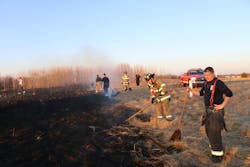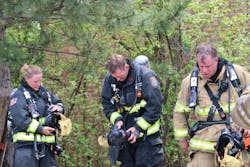Download the full PDF SMARTER: Advancing Health-Related Technology here.
Firefighters use heavy and fully encapsulating PPE, perform strenuous work, and often operate in high environmental temperatures. Thus, an increase in core temperature is a nearly universal response to firefighting activity.
Heat stress is familiar to all firefighters, but perhaps it is so familiar that we fail to recognize the devastating consequences that accompany this condition. While most firefighters recover from this stress given adequate rest, cooling and hydration, the demands of firefighting can lead to serious heat illnesses. Heat stress can cause exaggerated cardiovascular strain, impaired cognitive function, early onset of fatigue, and heat illnesses, including heat exhaustion, heat stroke, and the related condition of rhabdomyolysis, which is the breakdown of damaged muscle tissue that releases proteins and electrolytes into the blood.
Despite the common nature of heat stress, and how devastating the consequences can be, body temperature is seldom assessed during firefighting or training because the technology simply does not exist to accurately and conveniently measure core temperature during firefighting. For example, oral temperatures significantly underestimate core temperature following heavy breathing or ingestion of fluids, tympanic thermometers severely underestimate core temperature, and the amount of the underestimation varies depending upon work performed and environmental conditions. Thus, both of these convenient and inexpensive tools are likely to underestimate core temperature and may lead to a missed diagnosis.
Military research
Firefighters are not the only personnel who face heat stress challenges as they perform critical and strenuous work. Military personnel also face heat stress challenges and suffer casualties due to the combination of heavy work, the use of PPE and environmental extremes.
Exertional heat illness at military training facilities has been a perennial problem. Even with greater recent awareness of the heat injury problem, over 3,600 cases of heat illness, with nearly 600 life-threatening heat strokes were recorded at military training installations in the last four years. The U.S. Army Research Institute of Environmental Medicine (USARIEM) has been tackling this problem by developing real-time physiological status monitors, but also found that, similar to other occupations, assessing core body temperature accurately in the field is a complex undertaking.
To address this problem, the researchers used advanced computational methods utilizing a tracking algorithm borrowed from engineering to estimate core body temperature from measurements of heart rate. These approaches, often used in engineering tracking problems, utilize two pieces of information to better estimate core body temperature: 1) how core body temperature changes over time and 2) how heart rate and core body temperature are related over time.
The USARIEM researchers used data from U.S. Army soldiers engaged in 24 hours of field training to develop these relationships. This Estimated Core Temperature (ECTempTM) algorithm has been validated across many laboratory, field and operational settings, including cool (11 degrees C) to very hot (42 degrees C) environmental conditions; various clothing ensembles (shorts and T-shirt, combat uniforms, body armor, and encapsulating PPE); different work rates, from sleep to heavy exercise; hydrated versus under-hydrated conditions; and heat-acclimated versus non-heat acclimated conditions. Overall, the ECTempTM algorithm has been validated in over 14 studies with more than 300 subjects, and generally performs reliably from study to study with an error margin of ±0.30 degrees C. For the military, the algorithm is proving successful and is being implemented in its current form in several commercial physiological monitoring systems, and used with success in both the National Guard Weapons of Mass Destruction Civil Support Teams and with the U.S. Air Force.
While ECTempTM has proved successful for the military, moving it into another setting requires adjustments. As the algorithm uses time sequences of heart rate to assess core body temperature, the basic underlying relationship needs to be adjustable for age, as both resting heart rate and maximal heart rate change by age. Similarly, for firefighting applications, the algorithm needs to be able to work for multiple sequences of firefighting bouts encompassing high-intensity work with recovery periods. Additionally, as firefighters encounter extreme heat, the algorithm must adapt to passive heating scenarios where the body can no longer dissipate any heat but instead is gaining heat from the fire.
Next steps
The SMARTER program is collaborating with USARIEM researchers to address these improvements, initially examining past firefighter research data of intermittent bouts of firefighting where the algorithm appears to perform as well as for military subjects. The collaboration will further update the algorithm and validate these updates from field research data planned with the SMARTER team.
Read more about the SMARTER project and related studies at skidmore.edu/responder.
Learn more about the research happening at USARIEM at usariem.army.mil/index.cfm/research.
More from SMARTER: Advancing Health-Related Technology
Dr. Denise Smith
Dr. Denise Smith is a professor at Skidmore College and a research scientist at the Illinois Fire Service Institute (IFSI). She conducts research on the heat stress and cardiovascular strain associated with firefighting, pathoanatomic cause of firefighter fatalities, and strategies to increase performance and decrease cardiovascular events in the fire service.
Mark Buller
Dr. Mark Buller gained his doctorate in computer science from Brown University in computational physiology. He is a principal investigator with U.S. Army Research Institute of Environmental Medicine with over 20 years of experience fielding physiological monitoring systems for warfighters. His current research focuses on real-time feedback and performance optimization.








